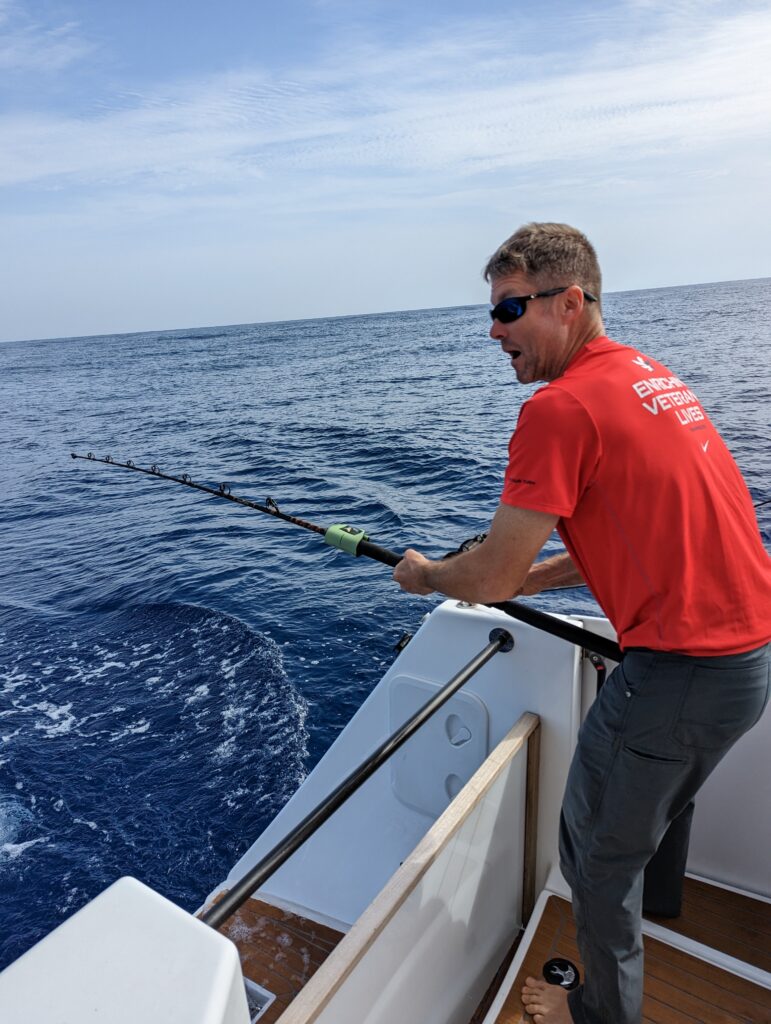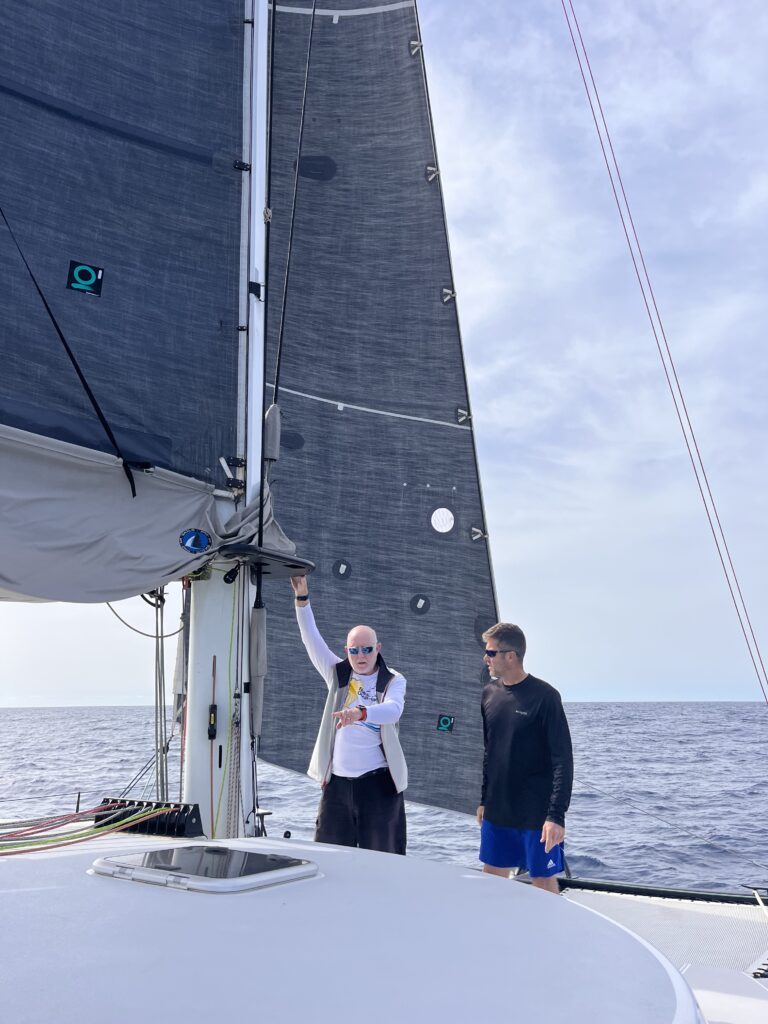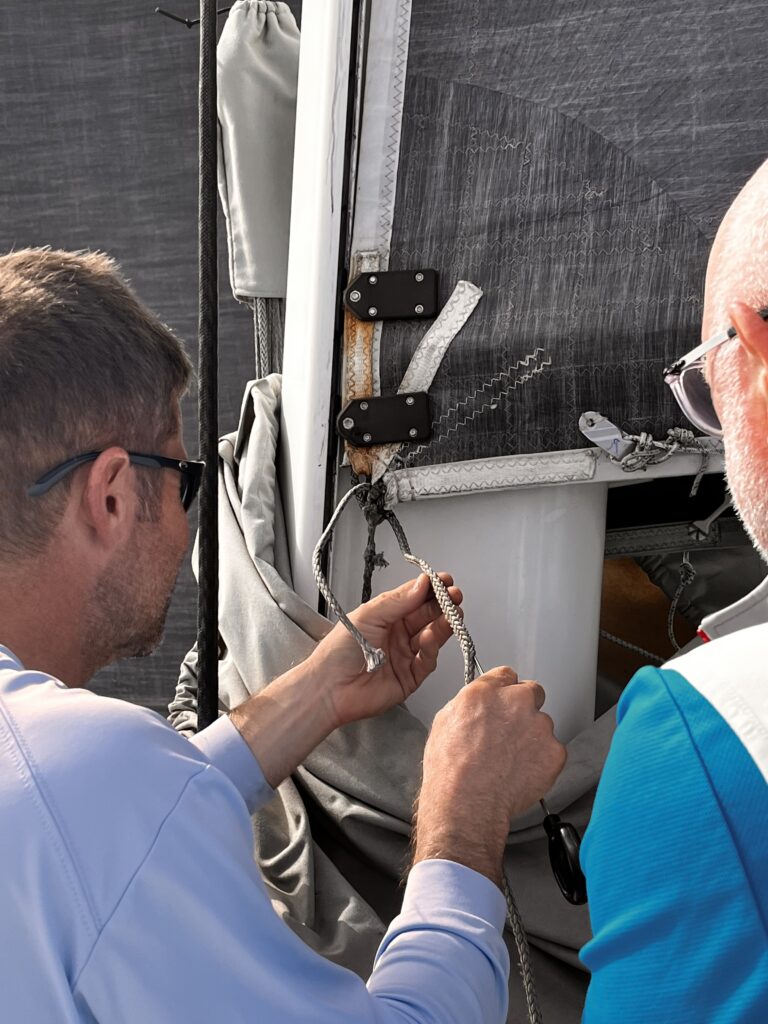Drama on the High Seas in the Strait of Gibraltar
On October 28th, we decided to chase a slight weather window to make the jump to the Canary Islands. One longest multi-day trip to date. It will be a good test to make sure everything is working and in order for the big crossing. We were informed by many a cruiser who went before us that long distance cruising is 90% Tranquility and 10% Terror. This passage certainly lived up to that sentiment.

The Challenges of Transiting the “Gate to the West”
Over the course of the week we sat waiting, there was a lot of discussion on how to tackle sailing through this narrow passage. There are a number of factors that go into traversing the area safely. The Strait of Gibraltar is very narrow with only 8 miles (13km) of ocean separating it’s narrowest point which lies between Punta de Tarifa, Spain and Point Cires of Morocco. To add to the fun, it is one of the busiest shipping channels in the world…approximately 300 ships cross the strait every day (~ one every five minutes!) Big ships. Huge!
Additionally, this is where the Atlantic ocean meets the Mediterreanian Sea. The salinity (due to different evaporative forces, the Atlantic Ocean is way less salty than the M. Sea), water temps, tidal and wind forces (look out for those Levante winds!) create very unique and sometimes challenging transit.
We poured over the tidal current charts. The maximum rates of tidal streams are about 3 knots in the W-going direction and about 2-7 knots in the E-going direction. Getting our departure timing wrong would make for a very long painful day where we could potentially make little to no progress! Looking back, we didn’t get it wrong, but we didn’t get it quite right either!


A New Threat to Transiting Boats
One other small factor of note…beginning in 2020 and increasing since, local pods of orcas have seemingly decided that sailboat rudders make fun chew toys. There have been numerous reports of them deliberately attacking, and occasionally sinking, transiting boats. We had met a few people along our travels that either had these encounters themselves or had friends whose boats were damaged, so this was becoming pretty common. The motivation behind the attacks is still unknown. My favorite theory being the attacks were started by “White Gladis,” a whale hellbent on retaliation due to some previous traumatic encounter with a boat involving her or her offspring. She has since taught other whales her devious tactics. Playful antics or massive revenge plot? We may never know. Either way there are a lot of theories on how to best avoid them and/or deter them if they show up at your boat. None proven. We hoped they would just avoid us and us them.
Knowing all this, we had a big choice to make in our navigation plans and timing to handle the current, traffic and whale avoidence. Do we go down the middle of the strait where we would get the most of the current (good or bad depending on timing) or hug the African coast where we are less effected by the strong currents, but less likely to encounter the shipping traffic and orcas. We chose the former mostly because we had not heard of recent orca encounters in the area and the African coast is a literal mine field of crab pots just waiting to taking out your props. With a plan in place, it was time to go.

Go Time
After we filled our bellies with a big breakfast, we leisurely secured everything on the boat while Kevin walked over to the main office to check us out of Gibraltar and square up our remaining bills for dock water and power. We departed to light winds and a lot of traffic, both anchored and moving. We carefully picked our way through the channel and entered the straights. The current was not in our favor as we would have liked, but we were making progress, albeit slowly and expected it to shift over the coming hours. We had very light winds coming from behind and no waves. Perfect Spinnaker weather! Up it went. With everything looking and feeling good, we settled in and enjoyed the views of neighboring continents.

Loud “Boom” = Bad!

As we approached Punta de Tarifa, the sounternmost point of the Iberian Peninsula and Continental Europe, the real “fun” began. The winds picked up to around 15-18 kts and seas, with 6 kts of current, got very confused and choppy creating a whirlpool effectIt felt like we were in the middle of a pot of boiling water. We were prepairing to pull the spinnaker down when there was a loud boom, like a firework that reverberated through the boat. It was so loud, I (Erin) lying down below deck thought we had hit something like a shipping container or another boat. When I came topside, everyone was running around trying to figure out what it was. The Spinnaker was still flying at this point and everyone was looking down around the boat.
However, upon looking up, the top of the spinnaker was out a few feet farther than it should have been. Right then, we heard another snapping sound and the spinnaker blew over the front of the bow. We stopped the motors from spinning in regeneration mode and rushed to try and pull the massive sail in. Louis worked his but off trying to pull it in but could only get so far. The lines and about half the sail came out, but sail was stuck on something. Upon further inspection, the leech of the sail had gotten wrapped around our port OceanVolt prop, which had been creating almost 2kW of power and was spinning VERY fast. We quickly made a “Pan Pan” call that we were adrift in the strait while we figured out what we needed to be done in order to free the Spinnaker, oh, and determine if the mast was ok. The rigging seemed stable enough, so someone was going to have to get in the water. Did I mention that we were in the narrowest section (8 miles across) in one of the busiest shipping lanes in the world?!

Kevin had no choice as the only member of crew with a wetsuit on board, to go under the boat and determine the extent of the damage. He was NOT happy about this. He LOVES diving all over the world. In that 900 meters of water under the boat lives lots of other “fun” marine life. Swimming at the surface under the the boat dressed as a seal in “hangry orca infested waters” did NOT excite him.
Kevin takes a Leisurely dip
Erin manned the helm and radio, Kevin donned his wetsuit, Geoff and Louis rigged up some lines and fenders to use as floats and safety lines for Kevin. I sent out another pan pan call updating our position so other boats knew to stay clear. We did notice a few other sailboats put their sails down, slowed and creeped up appearing ready to assist which was comforting. As the boat rocked in 3-4’ seas, Kevin jumped in with his gear and knife. Geoff kept watch and Louis made sure Kevin had everything he needed. In the water for only about 10-15 minutes (which felt like hours to him), he managed to cut the tangled sail free, assess there was no damage to the saildrive or props and climb out utterly exhausted. The large pod of dolphins (we think) that swam under him while he was working did not help his nerves!

Is that a Hole in the Mast?
Once we were settled down and got the motors going again, we noticed something sticking out of the top of the mast. It honestly looked like random wires. With binoculors, it became clear what happened. The spinnaker sheave block at the top of the mast broke and the halyard ripped through the carbon fiber before being sliced by the jagged edges the tear created and the wind sent the spinnaker overboard. We took pictures as best we could and, through our IridiumGo, messaged the engineers of the Advanced Wing System rig to determine what we could and could not do at this point.
Once they reviewed the info we sent, the believed that the rig was okay below the damaged section, but only really could the crew determine if it was safe to continue. We decided to continue. We knew we would be doing a lot of motor sailing for the most part in the light winds. We would just not fly our down wind sails off the front and keep the main reefed below compromised area of the mast until we got to Lanzarote and could safely go up the mast. We would continue to monitor the mast to ensure nothing new presented itself. Only about 5 days to go…



Calmer Days Ahead
What do Sailors want most on long passages besides fair winds and following seas…boredom! Boredom means nothing major is going wrong. Thanfully, once out of the Strait and into the Atlantic Ocean, the major drama seemed to be behind us. Everyone started settling into their routines. We stuck with the 3x 4 hour day watch followed by 6x 2 hour night watch rotation. It seemed to work for all on board and kept us all fresh. The following days seem to blend into each other, the crew passing time standing their watch, sleeping, reading, and enjoying the large pods of dolphins that would come visit off and on to play in our bow waves.

We managed to reel in a few tunas which expanded our daily culinary choices! Who doesn’t like fresh fish?! Kevin “fileted” them up as best he remembered. Geoff and I would go to work making sauces, marinades and sides (mango salsa anyone?) to go with our latest catch. We got creative on dinners when the seas were calm. I even made fresh bed and indian style naan to crew’s delight.


Regular boat chores interwined the moments of respite. With light winds pushing from behind and no downwind sails being used (due to the compromised mast), we ended up motoring more than we would have liked in between short periods of sailing. Kevin often transferred our spare fuel jugs into the main tanks through a filter to ensure only clean fuel went into the tanks for our generator. The oceanvolt motors will only last about an hour and a half on battery power alone so running the generator was necessary for long periods of motoring.
On Sunday’s We Brunch!
Every Sunday that Geoff is sailing as crew, he loves to make Brunch. Something to look forward to on long passages. For us, this landed right in the middle of our 6 day passage. Rummaging through our plentiful supplies, he made quite the late morning feast! Eggs made to order, potatoes mixed with beef jerky, fresh bread with avocado and butter and a very British side of baked beans with HP sauce. It was delicious. Being that Geoff was on watch after me in the early hours, I was a sleep while he cooked most of this up. Waking up to the smells of a greasy spoon diner worthy breakfast, was a fantastic surprise!

Land Ho!
A day or two after the drama in the strait, we pulled out the Spinnaker to assess the damage and dry her out. She was pretty beat up with a few tears that would have to be mended before our crossing. But the good news was that at least to us, it appeared to be repairable.
We had one other frustrating regularly occurring issue throughout the journey. Our AWS rig. The leach batten connection “whale tails” were starting to disinegrate. We would find pieces them on the deck every once in awhile. These parts hold the leeches of the two mainsails together to enable the sails to create the perfect wing shape. It’s what allows us to sail at higher speeds pointed more directly into the wind (we saw up to 28 deg Apparent at times). So a a very necessary component. We had few extras, but would it be enough to get us across to the US? Only time would tell. On top of that the soft shackles that were holding our two mainsail tacks in place were coming completely apart and had to be completely redone. The aggravation with our prototype rig was starting to build. Maybe it isn’t quite as built and designed for long term cruising as we were led to believe.



On November 2, 688 miles and just over 6 days from departing Gibraltar, we came with in view of land. A rugged island clearly shaped from volcanic activtity popped up in the distance seemingly out of nowhere. As we apprached, we noted the beautiful beaches and small towns that dotted the shoreline with a backdrop of hills and peaks in the distance. We sailed around to the south end where we dropped anchor at our first stop in the Islands of Eternal Spring, Playa del Pozo, Lanzarote.

Now it was really time to live the cruising dream…fixing things in beautful places.